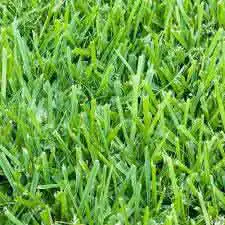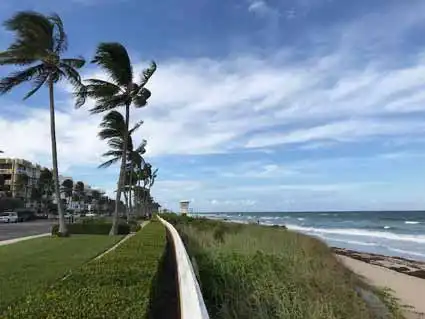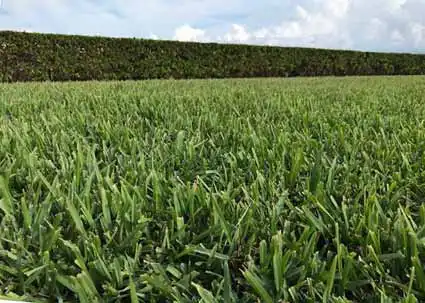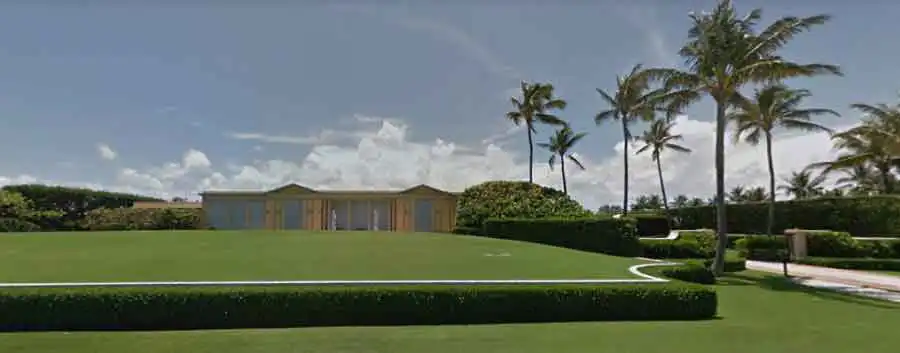If you want to ask for a free quotation for Saint Augustine Grass, please click here. Please, note that this option is only available for Brazilian customers
For more information, you may call us at the numbers below:
+ 55 (15) 3273-2644 (Itapetininga)
+ 55 (11) 3733-5989 (São Paulo)
+ 55 (15) 99630-5347 (whatsapp)

Saint Augustine Grass Stenotaphrum secundatum
The St Augustine Grass, also known as Buffalo Grass, Charleston Grass and Pemba Grass is originally from North America and is found all over the Americas (South, Central and North). It is also found at the Mediterranean regions, Pacific Islands and at New Zealand.
The St Augustine Grass adapts well to the areas with high incidence of sunshine but also to half shaded areas. Since it forms a very dense lawn, it resists well to the infestation of insects and weeds. Besides, it is ideal for the edges of ponds and for coastal areas where the humidity level is high. The St Augustine Grass grows well at the tropical climate areas.
The Characteristics
The St Augustine Grass presents flat, narrow, small and pointy leaves without hair. It has a dark green color and grows forming a very dense lawn.
The St Augustine Grass resists well to plain sunshine and half shaded areas. It is widely used for pasture and farms.
The St Augustine Grass is the competitor of the Bermuda grass. However, it is less resistant to trampling and to the drought when compared to Bermuda grass.
Where can I plant the Saint Augustine grass?
The St Augustine Grass is a rhizomatous type of grass, where the stem stays under the soil and emits the leaves aboveground. Therefore, the St Augustine Grass forms a very dense lawn and is widely recommended for:
- Residential gardens
- Closed neighborhoods
- Companies
- Pastures
- Farms
- Edge of swimming pools, ponds and rivers
- Coastal regions

When can I plant the Saint Augustine Grass?
The St Augustine Grass grows well during summer and therefore, it is recommended to be planted on the warmer season of the year. It does not tolerate the cold, consequently, planting the grass during the winter time and during the cold weather season is not recommended, especially at the southern regions of Brazil.
How to plant the Saint Augustine Grass?
Before receiving the grass: Prepare the site where the grass will be planted by removing all kinds of stones, dirt, weeds and debris. Try to prepare the soil more uniformly as possible without unevenness and small bumps. The fertilization in advance is not necessary, however, depending on the region, the consultation of a soil specialist or an agronomist engineer is recommended to verify and analyze the soil before planting.
The transportation of the grass: Normally, the St Augustine Grass is transported as grass carpet tiles of about 40 cm x 125 cm (16”x 49”) as rolls. This format makes it easier to plant and besides, it avoids damage to the grass that can be transported for long distances.
When the grass is received and unloaded: the St Augustine Grass must be planted immediately and the grass carpet tiles must be placed side by side. All area should be covered with earth afterwards.
Once the grass is planted: the St Augustine Grass must be watered daily and in abundance in the first 30 days.
Once the grass settles and adapted to the soil: the St Augustine Grass can be watered frequently, preferentially by using the automatic irrigation to avoid excessive loss of water and to optimize the homogeneous irrigation of the grass.
Grass trimming: the St Augustine Grass must be trimmed when the grass reaches 3 cm (1”).
Fertilization: the fertilization of the St Augustine Grass must be done every 4 months. Besides, if the grass is planted where the winter time is harsh and cold, it is recommended to cover the grass with earth during fall and winter.
Recommended cares
The St Augustine Grass should be grown at areas of plain sunshine or half shaded areas. It should be planted in fertile soils with fertilization done 3 times a year and frequent watering.
The St Augustine Grass does not tolerate intense trampling, and therefore, this grass is not recommended for areas of high circulation of people.
This grass multiplies through the division of rooted rhizomes.
The St Augustine Grass must be trimmed when it reaches 3cm (1”) and it should not be cut at more than 1/3 of its height. Trimming is recommended during spring or summer. Cut and dead leaves should be removed which makes the appearance of grass with a more vivid green.The ideal pH for the St Augustine Grass is between 5.0 and 8.5.
For more information on how to plant grass, click here.
Weeds and the Saint Augustine Grass
Since the St Augustine Grass forms a very dense layer of grass, it is very resistant to weeds. If there are some weeds at the moment of planting, the tendency is that the weed might disappear with the growth of the grass. The St Augustine Grass will suffocate the growth and multiplication of weeds. However, if the soil is widely infested with weeds before planting, it is recommended to remove the weeds and treat the soil prior to planting the grass.
For more information about how to combat the weeds, please read the article How to Combat Weeds.

Advantages
- It tolerates well both plain sunshine and half shaded areas.
- It is resistant to weeds
- It can be planted in areas of high humidity such as edges of ponds, rivers and swimming pools.
- It adapts well in soil with great pH variation. However, the ideal pH is between 5.0 and 8.5
- It requires less fertilization when compared to other types of grass. But it also depends on the region where the grass is planted. Therefore, the consultation of a soil specialist or an agronomist engineer is always recommended.
- It can be planted in areas where the salinity of the water and of the soil is high, such as coastal regions.
- It multiplies well during summer.
- It requires moderate maintenance when compared to other type of grasses.
Disadvantages
- It does not resist trampling and intense circulation of people.
- It does not tolerate the intense cold.
- If the St Augutine Grass grows too much, its trimming gets harder.
Format
The St Augutine Grass is grown in grass nurseries and is normally sold as grass carpet tiles (pallets), seedlings and rolls of 40 cm x 125 cm (16”x49”).

REAL GRAMAS' numbers:
+ 55 (15) 3273-2644 (Itapetininga)
+ 55 (11) 3733-5989 (São Paulo)
+ 55 (15) 99630-5347 (whatsapp)
More articles about Saint Augustin grass and the other grasses, you find here in our website. Check it out!
Emerald Grass - Carpet Grass - Bahia Grass - Korean Velvetgrass - Saint Augustine Grass - Bermuda Grass - Grass for your garden - The origin of grass - Landscaping and gardening - Types of grasses - Grass sale - Emerald grass with the best price per m2 - How to fertilize the lawn - How to eliminate weeds from your lawn - How to plant grass - How to plant Bahia Grass - Maintenance tips for your Emerald Grass - How to plant Emerald Grass
A NATUREZA DE BEM COM A VIDA!

 (15) 3273-2644
(15) 3273-2644
 (11) 9 9009-1813
(11) 9 9009-1813
Very good information on Saint Augustine Grass. I loved the photos too! They are really great. I love living in the beach area.